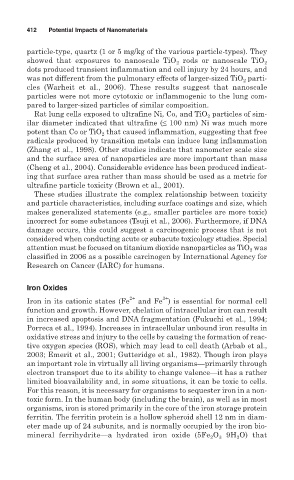Page 432 - Environmental Nanotechnology Applications and Impacts of Nanomaterials
P. 432
412 Potential Impacts of Nanomaterials
particle-type, quartz (1 or 5 mg/kg of the various particle-types). They
showed that exposures to nanoscale TiO rods or nanoscale TiO 2
2
dots produced transient inflammation and cell injury by 24 hours, and
was not different from the pulmonary effects of larger-sized TiO parti-
2
cles (Warheit et al., 2006). These results suggest that nanoscale
particles were not more cytotoxic or inflammogenic to the lung com-
pared to larger-sized particles of similar composition.
Rat lung cells exposed to ultrafine Ni, Co, and TiO particles of sim-
2
ilar diameter indicated that ultrafine (≤ 100 nm) Ni was much more
potent than Co or TiO that caused inflammation, suggesting that free
2
radicals produced by transition metals can induce lung inflammation
(Zhang et al., 1998). Other studies indicate that nanometer scale size
and the surface area of nanoparticles are more important than mass
(Cheng et al., 2004). Considerable evidence has been produced indicat-
ing that surface area rather than mass should be used as a metric for
ultrafine particle toxicity (Brown et al., 2001).
These studies illustrate the complex relationship between toxicity
and particle characteristics, including surface coatings and size, which
makes generalized statements (e.g., smaller particles are more toxic)
incorrect for some substances (Tsuji et al., 2006). Furthermore, if DNA
damage occurs, this could suggest a carcinogenic process that is not
considered when conducting acute or subacute toxicology studies. Special
attention must be focused on titanium dioxide nanoparticles as TiO was
2
classified in 2006 as a possible carcinogen by International Agency for
Research on Cancer (IARC) for humans.
Iron Oxides
2+ 3+
Iron in its cationic states (Fe and Fe ) is essential for normal cell
function and growth. However, chelation of intracellular iron can result
in increased apoptosis and DNA fragmentation (Fukuchi et al., 1994;
Porreca et al., 1994). Increases in intracellular unbound iron results in
oxidative stress and injury to the cells by causing the formation of reac-
tive oxygen species (ROS), which may lead to cell death (Arbab et al.,
2003; Emerit et al., 2001; Gutteridge et al., 1982). Though iron plays
an important role in virtually all living organisms—primarily through
electron transport due to its ability to change valence—it has a rather
limited bioavailability and, in some situations, it can be toxic to cells.
For this reason, it is necessary for organisms to sequester iron in a non-
toxic form. In the human body (including the brain), as well as in most
organisms, iron is stored primarily in the core of the iron storage protein
ferritin. The ferritin protein is a hollow spheroid shell 12 nm in diam-
eter made up of 24 subunits, and is normally occupied by the iron bio-
mineral ferrihydrite—a hydrated iron oxide (5Fe O 9H O) that
2
2
3

